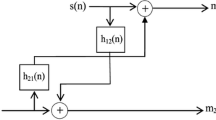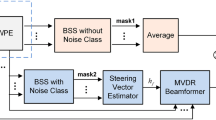Abstract
In this paper, exclusive activity periods (EAPs) are used to model crosstalks in which only one blind source separation (BSS) output signal is assumed to be active and the others are inactive. Inactive intervals of each EAP are used to estimate the crosstalk leaked from each active signal using a least squares method. Then, we use the Wiener filter to cancel the estimated crosstalks from BSS outputs. The benefit of using EAPs is to simplify the estimation of crosstalks from all other signals to the estimation of them from just one active signal in each interval. Thus, it leads to estimate and suppress crosstalks more precisely. A comparison of our method with other popular post-processing algorithms is drawn. The results show an improved performance of the proposed method over earlier approaches.








Similar content being viewed by others
References
R. Aichner, M. Zourub, H. Buchner, W. Kellermann, Post-processing for convolutive blind source separation, in Proceedings IEEE International Conference on Acoustics, Speech, and Signal Processing (ICASSP), (Toulouse, France, 2006)
D. Campbell, K. Palomki, G. Brown, A matlab simulation of ‘shoebox’ room acoustics for use in research and teaching. Comput. Inf. Syst. J. 9(3), 48–51 (2005)
V. Emiya, E. Vincent, N. Harlander, V. Hohmann, Subjective and objective quality assessment of audio source separation. IEEE Trans. Audio Speech Lang. Process. 19, 2046–2057 (2011)
E. Jani, H. Saruwatari, K. Shikano, Enhanced Wiener post-processing based on partial projection back of the blind signal separation noise estimate, in European Signal Processing Conference (EUSIPCO 2009) (2009)
D. Kolossa, R. Orglmeister, Nonlinear post processing for blind speech separation, in Proceedings ICA, LNCS, vol. 3195 (2004), pp. 832–839
Z. Koldovsk, P. Tichavsk, Time-domain blind audio source separation using advanced component clustering and reconstruction, in Hands-Free Speech Communication and Microphone Arrays (HSCMA 2008), 6–8 May, Trento, Italy (2008)
S.Y. Low, S. Nordholm, R. Togneri, Convolutive blind signal separation with post-process. IEEE Trans. Speech Audio Process. 12(5), 539–548 (2004)
Y. Mori, H. Saruwatari, T. Takatani, S. Ukai, K. Shikano, T. Hiekata, T. Morita, Realtime implementation of two-stage blind source separation combining SIMO-ICA and binary masking, in Proceedings 2005 International Workshop Acoustics Echo Noise Control (2005), pp. 229–232
R. Mukai, S. Araki, S. Makino, Separation and dereverberation performance of frequency domain blind source separation, in Proceedings of International Conference on Independent Component Analysis and Blind Signal Separation (ICA2001) (2001), pp. 230–235
R. Mukai, S. Araki, H. Sawada, S. Makino, Removal of residual crosstalk components in blind source separation using time-delayed spectral subtraction, in Proceedings IEEE International Conference Acoustics, Speech and Signal Processing, vol. 2, (2002), pp. 1789–1792
R. Mukai, S. Araki, H. Sawada, S. Makino, Removal of residual crosstalk components in blind source separation using LMS filters, in Proceedings Neural Network Signal Processing (2002), pp. 435–444
G. Naik, Measure of quality of source separation for sub-and super-Gaussian audio mixtures. Informatica 23, 581–599 (2012)
R.M. Nickel, A.N. Iyer, A least-squares approach to blind source separation in multispeaker environments. J. Comput. 2(7), 59–67 (2007)
T. Noohi, M.H. Kahaei, Post-filtering algorithm for cross-talk cancellation in blind source separation outputs. IET Signal Process. 6, 239–246 (2012)
D. Pearce, Enabling new speech driven services for mobile devices: an overview of the ETSI standards activities for distributed speech recognition front-ends, in AVIOS 2000: Speech Applications Conferenece, vol. 5 (2000)
E. Vincent, R. Gribonval, C. Fevotte, Performance measurement in blind audio source separation. IEEE Trans. Speech Audio Process. 14(4), 1462–1469 (2006)
Author information
Authors and Affiliations
Corresponding author
Rights and permissions
About this article
Cite this article
Noohi, T., Kahaei, M.H. A Post-filtering Algorithm for Crosstalk Subtraction in Blind Speech Separation Outputs. Circuits Syst Signal Process 34, 3057–3070 (2015). https://doi.org/10.1007/s00034-015-0001-0
Received:
Revised:
Accepted:
Published:
Issue Date:
DOI: https://doi.org/10.1007/s00034-015-0001-0




